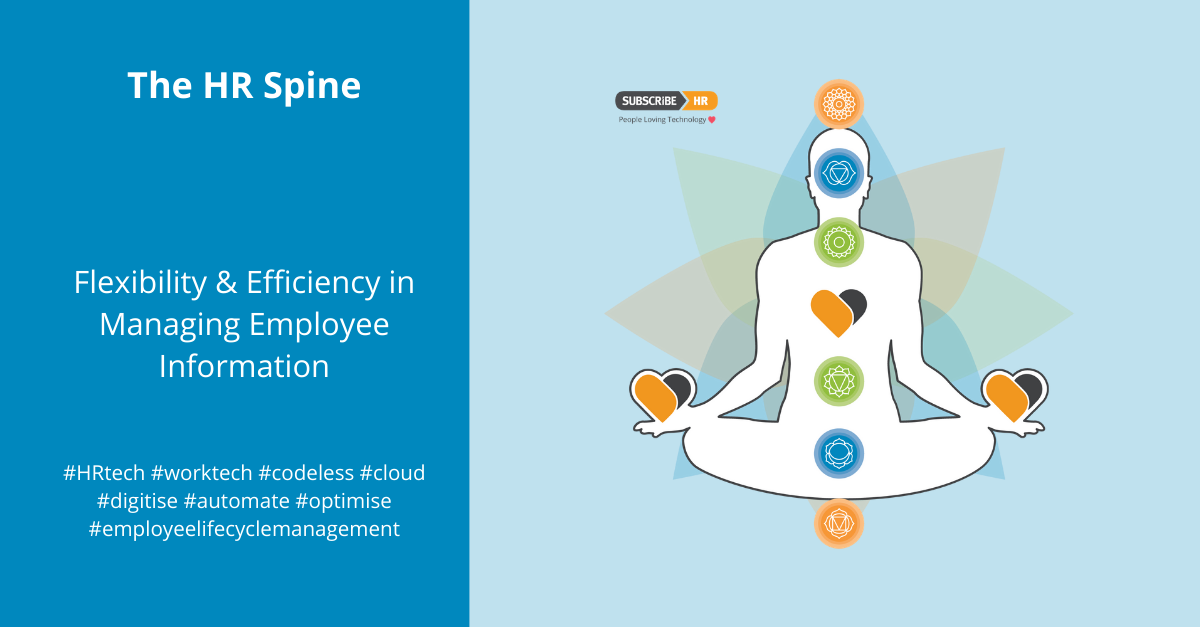A healthy spine is flexible, keeps the body in alignment and transmits messages accurately and efficiently from the brain to the rest of the body. In the same manner, the key to flexibility, efficiency and effective management of employee information in HR, is to allow for a smooth flow of data between all the convergent data points that HR management generates. Given the amount of disruption to the way we work in 2020 - what are the convergent data points that HR needs to optimise to ensure that there are no bottlenecks in the employee lifecycle going forward? Let's take a look.
If ever there was a moment when HR Professionals and Managers were overwhelmed by admin fatigue, 2020 was definitely the year for it. Let's face it, people management involves shuffling A LOT of 'paper'. Let’s be honest, manual handling of paperwork and 'crunching the numbers' using spreadsheets generates massive inefficiencies. And yet, there are still many HR professionals relying on such ways of working, even in 2020. If you still have to shuffle paper because you don’t have systems in place to enable digital management of such paperwork, that's a lot of time, energy and money that you could have been spending on more important things. Like taking care of your employees and making sure they had the support they need to stay well and productive.
How Healthy is the Spine of HR in Your Organisation?
The agility and resilience of the human body is predicated on the flexibility of the spine. Similarly, HR systems (and processes) that revolve around a 'Spine' specifically designed to deliver HR services better, ensure the success of your organisation. It also allows for democratic integration (and seamless data flow) to specialist business applications, ensuring that there are no bottlenecks in the employee lifecycle.
Along the spine of your HR processes and workflows, there are certain flexion points that require smooth transitions and seamless data communication. Always. Roadblocks at any of these junctions have the potential to produce catastrophic results. Not just in relation to user experience (that of your employees), but also in the context of compliance (not to mention basic functioning). Get one of those wrong and there will be trouble. It isn't even worth thinking about the consequences of getting both wrong.
After over a decade of experience working with our customers and observing their pain-points, it has become crystal clear that HR systems (and processes) must facilitate a seamless flow of data through the following junctions:
-
Requisition (Request to Hire).
-
Applicant Management.
-
Hire Authorisation.
-
Onboarding.
-
Employee Data Management including Work Patterns.
-
Jobs, Salary.
-
Company Property.
-
Training Requirements.
-
Manager Relationship.
-
Absence Management.
-
Task Management.
-
Training and e-Learning.
-
Performance.
-
Remuneration and Payroll.
-
Crossboarding and Offboarding.
Pause for a moment and run through that list again. For each bullet point, assign a tick or a cross for whether your organisation has digitised, automated and optimised that process (or processes)? How many ticks did you get out of 15? If you got less than 15, ask yourself why?

Digitisation Still Isn't a Priority - But It SHOULD BE
Don't worry, you're not alone if you scored less than 15 on the above exercise. In 2020 there are plenty of organisations still using spreadsheets and paper to manage HR. KPMG’s annual The Future of HR report illustrates that in 2019, only 40 per cent of HR leaders said they had a digital work plan in place at the enterprise or HR level. Less than half!
Many organisations that run lean, with small teams and tight budgets, often cite time and money as the reasons for not embarking on a digital transformation. As we've shared several times this year, you might be surprised to hear that it isn’t always just time and money which are the barriers to making the transition. According to KPMG’s research, a whopping 41 per cent of respondents consider workplace culture to be a top barrier to digital transformation.
The truth is, it really doesn’t have to be that way. And more to the point, it shouldn't be that way. Especially after the way 2020 played out. Seriously.
Improve the Spine of Your HR Systems and Processes
If you’re an HR professional, there are so many ways for you enhance the agility and resilience of HR in your organisation so as to remove any roadblocks from the employee lifecycle. You can find out how to cut costs and drive efficiency here. You can explore the importance of culture here. You can examine essential workforce shaping tools here. The possibilities are endless, but the benefits often include:
-
Efficient workflows and processes.
-
Enhanced compliance and reporting.
-
Real-time insights for better decision-making.
-
Accurate and effective records management.
-
Better resource allocation and increased productivity..
If you're ready to find efficiencies, save money and make the spine of HR in your organisation more flexible than it has ever been, then you need codeless, cloud #HRtech. To find out more about how our suite of 13 HR software solutions can transform your HR Spine, take a tour of the Discovery Centre - it contains everything you need to build a business case.


